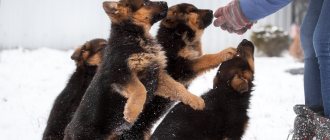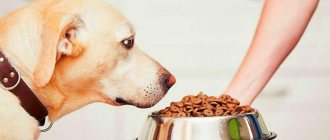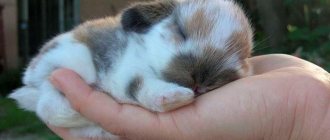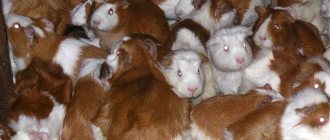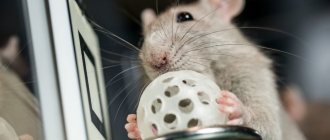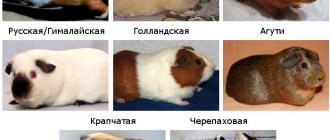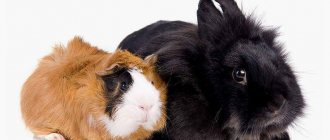Small, cute and affectionate Labrador puppies are like teddy bears that you want to pet, take in your arms and, without letting go, take them home. But we must not forget that a puppy is not a toy. It requires competent care and education, proper feeding, daily attention and patience.
Having a pet is not only about positive emotions. This is responsibility for a living being.
Knowing and following all the recommendations and advice on keeping an animal will help you grow a puppy into a devoted friend, an excellent companion and a true protector.
How to choose a future pet
If you know what a Labrador puppy looks like, it will be easier to make the right choice and buy a real purebred purebred pet. A newborn Labrador's eyes and ears are initially closed.
A caring mother dog warms the puppies, providing them with the necessary comfortable body temperature. Up to 2 weeks of age, babies crawl and suck mother's milk. They sleep almost all the time.
After 10–15 days, Labrador babies develop palpebral slits. Newborn puppies begin to see. They also develop hearing and smell.
Newborn Labrador puppies weigh approximately 400–500 grams. During the first month of life, they gain 100–150 grams daily.
A small Labrador puppy at the age of 1 month looks like an adult dog, only much smaller. Puppies become more active, respond to sounds and begin to recognize people. Small pets move more boldly and even try to run.
Labrador Retriever puppies are characterized by 3 colors, each of them is considered correct and standard for the breed:
- A black Labrador puppy at 2 months of age is very beautiful and attractive. During this period, the baby’s coat is not very bright. But an adult black Labrador has a gorgeous, shiny coat.
- A fawn Labrador is usually somewhat unevenly colored (the back and ears of the animal are often slightly darker than the base tone). All puppies in shades between pure white and fox fall into this category. Golden and red Labradors are also defined as fawn colored dogs. Pets of such unusual and multifaceted colors look interesting and attractive. However, grown fawn Labrador puppies may become lighter or, conversely, darker over time.
- A purebred Labrador can be brown in color. Reddish brown, dark chocolate and sand colors are also allowed by the standard. Your pet's brown coat may change - over the summer it may fade and become less bright.
A white Labrador puppy looks no less attractive, but is considered a waste.
When choosing the gender of a puppy, you need to consider the following nuances:
| Gender of the dog | Advantages | Flaws |
| Labrador boy | Active | cocky |
| Cheerful | Due to the large size of the dog it is difficult to keep on a leash. | |
| Playful | ||
| Devoted | ||
| Labrador - girl | Obedient | The main problem is estrus and unwanted pregnancy |
| Affectionate | Sometimes – excessive independence, independence | |
| Devoted | ||
| With a calm character |
If there is a child in the family, then it is better to buy a female puppy. Adult female dogs find it easier to get along with children.
In general, all Labradors, regardless of gender, are very smart and friendly dogs. And negative behavioral manifestations are corrected in the process of raising a pet.
Externally, a Labrador puppy should look like a healthy animal. At the same time, the baby is active, curious about everything new, and does not show aggression. When buying a pet, you need to look at its parents and make sure of its breed.
It is worth asking about the presence of any diseases in the mother and father of the baby that could be inherited.
Where to buy a puppy, cost
Of course, you can buy a puppy at the market. But it is better to find a good breeder - the owner of a dog kennel where Labradors are raised. An experienced professional dog handler will help you choose a pet based on its temperament and give recommendations on the care, maintenance and training of the animal.
In the nursery you can see the puppies' parents and understand what your dog will be like in the future. The seller-breeder will easily provide all the necessary documents for the dog and certificates of vaccinations.
You can buy a baby without vaccinations and documents by paying from 5 to 15 thousand rubles. Animals with a passport cost a little more – 20–25 thousand. But such Labradors are unlikely to become exhibition winners in the future.
If you plan to exhibit a purebred pet at competitions, you should not skimp. RKF offers Labrador Retriever puppies at higher prices - from 35 to 45 thousand in rubles. This is due to several factors:
- popularity of the nursery or club;
- well-deserved titles of the puppy’s parents;
- individual characteristics of the animal;
- pet health indicators;
- dog's prospects.
Prices for Labrador puppies in Moscow and the regions vary from 40 to 60 thousand rubles. Here a lot depends on the breeder himself. Such an expensive puppy usually has exceptional characteristics and all the necessary pedigree documents. A Labrador dog costs more if it is a girl.
Interesting to know! The Labrador Retriever is native to the island of Newfoundland in eastern Canada.
The breed was originally a hunting breed. But today Labradors are used as excellent guide dogs, rescue dogs and wonderful companions.
However, some owners who are passionate about hunting are quite successful in training their Labrador puppies, turning them into real hunting dogs.
From 4 to 8 weeks (1-2 months) - socialization stage
Once the puppy reaches 4 weeks of age, he will begin to learn the most important things in his life related to social behavior. He will learn not to bite and interact with other dogs and animals.
Social interaction with people is especially important between the 5th and 8th weeks. During this time, the puppies will also learn discipline from their mother. She will begin to wean her puppies and teach them proper manners.
You can begin to gradually introduce regular food into your puppy's diet from about 4 weeks of age. Start with small amounts as the mother is still feeding them.
Make sure to exercise your puppy regularly every day. But do not separate him from his fellow dogs for more than 10 minutes, as this may lead to problems with socialization.
Dogs that have been separated from their mother and litter too early may be more nervous and bark and bite more often. Problems with further training and socialization can also often be attributed to puppies that are separated from their siblings too early.
Photos of Labrador puppies 1.5 months old:
Photos of Labrador puppies 2 months:
Basic rules for caring for a puppy
Caring for a Labrador puppy requires the owner to have certain knowledge and skills. Bathing an animal, combing its fur, brushing its teeth and ears, and trimming its claws - you need to learn all this and try to carry out the necessary manipulations patiently and conscientiously.
Your pet should be accustomed to hygiene procedures while it is small, otherwise problems may arise later.
Cleaning teeth and ears
Cleaning a dog's teeth and ears should become a habit for both owner and pet. The health and well-being of your Labrador depends on the regularity of these procedures. Before starting the procedure, you must carefully examine the animal's ears and teeth for infections, wounds or inflammation.
For ear hygiene, use a cotton pad soaked in a special lotion for cleaning the ears. You should pull the animal's ear back and gently wipe its surface from the inside. Lotions dissolve earwax very well.
Do not use alcohol- or oil-containing liquids. It is not recommended to use cotton swabs or tweezers wrapped in gauze to clean your ears. The skin inside the ears is thin and delicate, and it is very easy to damage it.
Your pet's teeth also need regular care. The procedure is carried out with a special dental product purchased at a pet store. You can brush your dog's teeth with your finger wrapped in a bandage or with a dog tooth brush.
These hygiene measures should be carried out at least once a week.
When teeth change
At 3 months old, a healthy Labrador puppy looks like a completely happy, restless and cheerful animal. The only thing that can interfere with him during this period of life is changing teeth.
A Labrador's teeth change between the ages of 3–3.5 and 9 months. The milky ones are replaced by permanent ones.
The process of changing teeth takes place in the following order:
- at about 3 months the primary incisors change;
- from 4 to 5 months, premolar teeth grow;
- At 6 months, a Labrador retriever's fangs fall out and molars—molars—appear;
- Usually at 9 months the animal should have 42 teeth - a full set of adult pets.
During this period, it is necessary to inspect the dog’s mouth more often (2-3 times a week). If a baby tooth is very loose, you can pull it out by carefully grasping it with two fingers.
When the process of replacing teeth is very late, it is worth contacting a veterinarian. Timely replacement of teeth in a Labrador affects the correct formation of the bite and jaws.
It is important to know! During the change of baby teeth, the puppy needs to gnaw or chew something. To prevent your pet from damaging your shoes or furniture, you need to give him a toy or ball. You can also massage your gums.
In large breeds of dogs, the process of replacing teeth goes smoothly. However, during this difficult period you should refrain from vaccinations and feed your dog properly.
Nail trimming
Nail trimming is carried out with special forceps - a nail clipper. This is done very carefully so as not to damage the paw pads and not to cut the claw very deeply. It is better if someone holds the puppy while doing this.
Carefully taking the dog's paw in your hand and spreading the fingers, you need to cut off the ends of the claws parallel to the pads. Then, when the pet gets used to the procedure, it will be possible to do without outside help.
Grooming
Caring for the coat of a small Labrador is not difficult at all, as it is smooth and short. It is enough to brush your pet 2-3 times a week with a dog brush. To prevent your pet from developing dandruff, you can wash it with a special shampoo. However, you should not bathe your dog very often - once every one and a half to two months is quite enough.
During the bathing process, you need to make sure that water and shampoo do not get into the eyes, ears or mouth of the animal. Labradors are usually not averse to swimming and playing in a pond, but not all dogs like swimming.
How to care for Labrador puppies at the age of 1 month? A similar problem can arise if for some reason the mother dog is not around. First of all, you need to monitor the body temperature of small puppies. Normally, it should be no lower than 35 degrees. Puppies should eat every hour and a half.
It is advisable that the mother feeds them herself. It is necessary to monitor the baby's weight gain. If there is a shortage, you need to start feeding them.
Introducing complementary foods
The first complementary foods are given to puppies after teething. This is a soaked specialized dry food or homemade diet.
Both of these options have their pros and cons, and professional breeders differ in their preferences. Expert opinion
Tolkachev Andrey Mikhailovich
veterinarian
I do not consider ready-made balanced foods, because I believe that any artificial mixture differs from “live” natural products. And the point here is not in the composition or selection of certain ingredients. Ultimately, you can choose any composition of proteins, fats and carbohydrates with vitamins and microelements, but it is impossible to guarantee the biological activity of the components of a freeze-dried (canned) product and their corresponding effective absorption, digestibility and utilization.
The puppy should be active and cheerful, with a good appetite and regular bowel movements. Any changes in the animal’s well-being and behavior - lethargy, refusal to eat, nausea, vomiting, diarrhea - require consultation with a veterinarian!
Feeding a Labrador puppy
Particular attention should be paid to the nutrition of the small Labrador. The stomach of a puppy of this breed is very delicate and reacts to the slightest change in diet.
First 3 months
Labrador puppies feed on their mother's milk for up to 1 month. At 2 months, the baby Labrador separates from his mother and moves into the house of his future owner.
The new owner’s task is to provide the two-month-old puppy with nutrition that is complete and safe for the animal’s body.
What to feed a 2-month-old Labrador puppy so that there is no shortage of calories and nutrients?
- Experienced breeders recommend starting with liquid cereals. The animal’s undeveloped teeth do not allow it to fully chew harder food.
- Gradually, you can add a little dry food to the diet, previously soaked in kefir or yogurt.
- Prebiotics should also be given to your growing puppy. They will help the unaccustomed stomach of a small pet.
A puppy up to 3 months of age must be fed every hour and a half. Feeding duration is no more than 15 minutes. You should not force feed your pet. But you shouldn’t allow a 2-month-old Labrador puppy to be distracted while feeding.
If the baby starts to indulge and play, you need to remove the food. Your pet should always have fresh, clean water in a bowl. Access to drinking water should not be limited.
It is important to know! If the animal refuses to eat or drink, it is imperative to contact a veterinarian.
A Labrador puppy up to 3 months old needs to be fed up to 7 times a day. The amount of dry food is no more than 50 grams at a time.
Feeding a grown puppy
After 3 months of age, a grown-up Labrador needs to reduce the number of feedings to 4-5 times a day, but the portions should increase (90-100 grams of food at a time).
If we talk about natural nutrition, then the diet of a growing Labrador must include:
- raw lamb and beef (finely or medium chopped);
- cottage cheese;
- kefir;
- boiled eggs;
- porridge (rice, buckwheat, oatmeal).
The share of cereals should not be more than a third of the daily amount of food, the remaining two-thirds are dairy and meat products.
Labrador retrievers under 4 months should not be given vitamins containing calcium. Otherwise, problems may arise with the replacement of baby teeth. When teeth begin to change, it is allowed to add vitamin complexes to food. If you feed your puppy ready-made dry food, there is no need for additional vitamins.
To choose the best dry food for your pet, you should pay attention to several nuances:
- the puppy should like the food and not cause allergies;
- the price is acceptable for the owner;
- quality is appropriate.
There is a special food for small Labradors - for the early period of the animal's life.
Pet health
Animals are quite fragile, so you need to contact a veterinarian with the slightest problem. Only a qualified veterinarian will help the dog. Representatives of this breed are prone to acute respiratory viral infections, allergies, and obesity. Dogs are regularly vaccinated according to the vaccination calendar.
The troubles of caring for a four-legged friend are more than compensated by having a faithful, kind and affectionate companion nearby. Moreover, the flexible nature of the Labrador allows him to get along well with the older generation and children.
Toilet training a puppy
At 2 months old, a Labrador puppy looks like a very smart, understanding animal. This is the best time to start toilet training your pet - at home and outside.
On the very first day of the puppy’s stay in his new home, it is necessary to determine the place where his tray will be located. When the puppy begins to behave restlessly and sniff, you should take him and show him a place where he can do his business.
If the puppy is not taken care of, he can make a puddle in any corner. Under no circumstances should you shout or hit your pet for this, because he is just learning. Some owners lay out diapers on the floor where the puppy has “marked.”
When the baby begins to urinate on them, the number of diapers is gradually reduced.
Sensing the smell and focusing on it, the pet gets closer to its toilet day by day. If the puppy goes to the litter box on his own, he must be praised and rewarded with a treat.
You can take a smelly diaper for a walk with your puppy. Having chosen a quiet place where there are fewer people and cars, lay out a rag and let the dog sniff. The puppy must understand what is required of him and go to the toilet outside. If this works, you need to praise your smart kid.
Over time, the animal will begin to ask to go outside to relieve itself.
When to wean from the bitch?
Labradors are large, often multiparous dogs.
If there are many puppies in the litter or the bitch has little milk, then it is often necessary to wean early, at 21-25 days. If there is enough milk, the puppies can continue to suckle their mother for up to 1.5–2 months.
If the bitch had a caesarean section, was treated with antibiotics or on the recommendation of a veterinarian, the puppies may be weaned earlier.
Vaccination schedule and which ones should be done
To raise a healthy Labrador and avoid frequent visits to the veterinarian, it is necessary to vaccinate the animal against all kinds of diseases on time.
Mandatory vaccinations for a Labrador in the first year of life:
- plague of carnivores (distemper);
- parvovirus enteritis;
- parainfluenza;
- rabies;
- infectious hepatitis;
- leptospirosis;
- trichophytosis;
- microsporia.
The first vaccination against plague is given to an animal at 2 months of age. The vaccination is quite difficult to tolerate: with fever, general weakness and diarrhea. The second vaccination (also against plague) is administered after 3 weeks. This time the Labrador should feel lighter.
At 2.5-3 months, it is necessary to vaccinate the animal comprehensively (one vaccine includes drugs against several diseases at once).
At 4 months of age, the puppy is vaccinated against rabies and the complex vaccine against a group of diseases is repeated. If your baby's teeth change during this period, you should wait. In this case, all vaccinations are given to the Labrador at 5 months.
At 1 year of age, the dog is revaccinated against distemper, rabies and other unpleasant and dangerous diseases with a complex vaccination. These vaccinations must be repeated every year.
Is the fairy tale a lie?
The stories you will be told when purchasing a dwarf Labrador are deceiving. And the following versions can tell:
- Representatives of the breed are very rare. They were bred specifically for hunting burrowing animals. Allegedly, the hunters really liked the working qualities of the dogs. But a regular Labrador is too big. So the hunters came up with the idea to produce a smaller copy of it. And it’s okay that the “labrick” is used as a swimmer. This doesn't bother anyone.
- A unique dog. A description of the Dwarf Labrador breed cannot be found anywhere. Clarification: not found in Russia. And abroad it is a common dog. She is the darling of high society. They can also slip in a pedigree in a foreign language. Like, look, here is the seal of the American Kennel Club, where the breed is registered. Just a minute: there is the American Kennel Club (AKC). That’s what it’s called when translated into Russian. Everything else is fairy tales for illiterate buyers.
- And one more trick from deceiving breeders. The dog is unique in that in Western countries it is used in the service of law enforcement agencies. There is nothing strange in this, if not for one “but”. The dwarf Labrador, it turns out, was bred by American canine services for detention. Can you imagine what nonsense? “Labriks” have never been used in detention work. This is absolutely not their competence.
Place for a puppy
In the house where a small Labrador puppy appears, you need to set aside a special place for the new family member. Soft bedding and favorite toys are mandatory attributes. The pet should know its nook where it can play and relax.
When the puppy is too annoying, you need to take him to the designated mat and sternly say: “Place!” Gradually, the pet will understand that this is its personal space and will go to its “place” at the owner’s command.
History of the breed
The breed has been known since the beginning of the 18th century. To date, there is no reliable data on the crossing, as a result of which the Labrador breed was developed. There is only a version that the Newfoundland was crossed with another breed.
At the very beginning of their appearance, Labradors helped sailors in pulling nets ashore. However, the status of a Labrador’s assistant remains relevant to this day, and Labradors provide assistance to people in a variety of areas. This dog is famous for its reliability and resistance to any difficulties in life.
Upbringing
There are several stages involved in training and raising a puppy. First, the pet must get used to its name and respond when called. Then the puppy needs to be taught the first commands (“Place!”, “Eat!”, “Walk!”).
Next, the animal must be taught to obey simple orders:
- "To me!";
- "Sit!";
- "Lie!";
- "Stand!";
- "Voice!";
- “Give me your paw!”;
- “Aport!”;
- "Fas!";
- "Near!";
- "Ugh!".
Naturally, command training is carried out gradually. You cannot demand everything from a dog at once. On each walk you need to consolidate the commands you have passed and add something new. Each time you should praise your Labrador for correctly carrying out an order. You can also treat your dog to something tasty.
You cannot use force or shout at the animal. The dog may become angry and withdrawn. Then it will not be easy to establish contact with your pet.
Important point! The puppy needs to be taught to stop biting in time. Small Labradors may bite when playing, and this habit must be stopped immediately. When a puppy bites, you should not pull your hand away. You need to scream for your pet to understand that you are in pain.
Origin
According to one version, the first mini-Labrador appeared as a result of a genetic mutation. The mother of the puppy, which never grew to normal size, was a full-fledged female, and the father was a male with dwarfism.
Important! Many unscrupulous breeders pass off dwarfism in dogs as an expensive and rare trait.
According to the second version, which also has a right to exist, short Labradors originated from crossing close relatives. Puppies born as a result of inbreeding have the same set of genes, which negatively affect growth and physical development. In other words, puppies stop developing before reaching normal levels.
The third version claims that miniature Labradors were born to a purebred female from an outbred male. Most likely, the father of “yard blood” was much shorter than his purebred lover, which affected the growth of the puppies born from their relationship.
In addition, various diseases and pathologies can affect the slowdown in the growth of puppies:
- diabetes;
- lack of growth hormone;
- improper functioning of the kidneys, thyroid gland, blood vessels and heart;
- skeletal dysplasia.
You should not believe that mini-Labradors were specially bred abroad for hunting or police service. It is also a lie that in other countries dogs with this feature are very popular and in demand. According to the rules, breeders do not have the right to put such puppies up for sale, even those with an impressive pedigree.
Walking and exercise
For proper development and good health, your puppy needs regular walks and physical activity.
Dogs of this breed love to frolic and run outside. The little Labrador is taught to carry out various commands.
But you need to take into account that the pet gets tired quickly. It is necessary to balance the load with the age of the dog. Typically 20–30 minutes a day are allocated for training. The rest of the time can be devoted to games and entertainment.
For walks, the puppy must have a comfortable leash and collar. Your pet should be trained to wear these outdoor accessories from childhood. The choice of special ammunition for an animal must be approached competently.
Collar for Labrador
To choose a good collar, you need to measure the volume of the dog's neck and add a few centimeters to this value. Puppies grow quickly, so it is better to buy a collar for growth.
For puppies, a product made of nylon is better (such collars are lighter). For an adult Labrador, you can safely buy a leather or canvas collar.
Leash for Labrador
A classic walking leash for a dog is usually made of nylon, nylon or leather. For a puppy, it is better to take a leash of moderate length - this will make it easier to restrain the curious little fidget.
A large adult Labrador requires a strong, wide leash with a durable carabiner. A product made of nylon or tarpaulin would be ideal.
Description of the breed
The photo of the Labrador Retriever shows that the breed is particularly strong and has a rather powerful build. The eyes of a Labrador are brightly defined. The paws are strong, the head is wide. The body shape resembles a square.
The Labrador's tail is not docked; it is quite dense and thick and is an extension of the back. The wool is medium length and waterproof.
The dog weighs on average from 30 to 40 centimeters, height at the withers reaches up to 55 centimeters. Due to its parameters, it may appear taller and larger than it actually is.
The Labrador is a single color. There are black, fawn and chocolate dogs.
Character
If nothing is indicated in the description of a dwarf Labrador, then the dog’s temperament is worth considering. Not to give her advertising. And for the purpose of educating the population, as they say.
First of all, I would like to warn you: any small dog is a deviation from the norm. May the owners of miniature breeds forgive the author of these lines, but it is among such dogs that there are individuals with a bad psyche. They are most often aggressive, unpredictable and bark hysterically.
Large dogs can also have disabilities. But from the same standard Labradors you know what to expect. These are very friendly dogs. As for dwarf Labradors, everything is unpredictable.
It’s worth starting with the fact that their growth is the result of mutation. And this always results in a violation of one or another body system. And it is not at all a fact that these pathologies do not concern the psyche.
Those who breed miniature Labradors assure: the dogs are kind, affectionate, love children, and are able to stop a criminal and pass a blood test without any problems. Dear customers, do not believe these fables. Standard Labradors are, in fact, kind and adequate dogs. They are considered excellent nannies. But they will not be able to stop the criminal, much less attack the attacker. The psyche is not designed for such stress.
They also like to refer to the fact that genetics can be corrected by education. This is true, but sooner or later their natural qualities will “shoot out”. If your dog has had problems with his head since childhood, you can suppress them. Until a certain point. In 6-8 years they will definitely come out. A kind and affectionate dog can turn into a monster. And it’s good if it’s small and doesn’t pose a particular threat to others. What if there is a large dog in front of you? What to do then? That's it, you will have to make the most difficult decisions.
